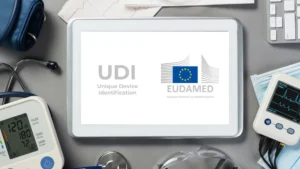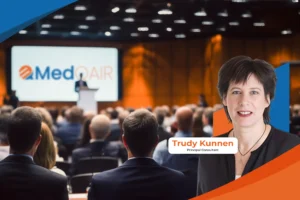MedQAIR’s Journey: Founding Story, Mission, and What Sets Us Apart (Q&A)
Regulatory compliance in the medical device industry is ever-evolving, especially with the rise of AI/ML-enabled medical devices. Navigating the regulatory landscape requires expertise, hands-on experience, and a forward-thinking approach.
Following our conversation with co-founder Ivo Flipse, we now turn to Leon Doorn, whose extensive experience in regulatory affairs, quality management, and AI/ML-enabled medical device compliance played a pivotal role in shaping MedQAIR’s vision.
From leading regulatory teams to influencing global standards, Leon shares his journey and what drives MedQAIR’s mission.
1. What inspired you to start MedQAIR, and why now?
Over the past 15 years, I have put a lot of my time into building other people’s organisations. When I joined my first role at Qserve, the organisation grew over the years I worked for them, supporting many medical device organisations in bringing their, often high-risk, medical devices to market.
As I had never worked for a multinational company, I decided my next step should be to join a large international manufacturer of medical devices. As such, I decided to join and support one in their efforts to bring their products to the EMEA markets, leading a team of regulatory and quality experts. Working in a multinational made me realize it comes with different challenges than working in smaller organizations. This is where I learned that my personal drive, being able to deliver in a fast and efficient manner, didn’t fit with the challenges typically experienced in these size organizations.
As such, moved a small and young organization, Aidence, one of the first manufacturers of an AI/ML-enabled medical device. As the Head of Compliance, I built up the regulatory and quality affairs team from day one and secured our CE marking, ISO 13485, and ISO/IEC 27001 certifications. Ultimately we submitted our FDA application after extensive FDA pre-sub interactions. It was a great learning opportunity and to date the organization I have enjoyed forking for the most. Eventually, Aidence was acquired by RadNet and DeepHealth, starting an exciting journey to become a larger medical device company, introducing new challenges I knew all too well.
Upon my decision to leave the organization, I quickly felt that I should start a new challenge where I could decide upon my own path. The level of freedom I experience in building our company is my main inspiration to grow the organisation day by day.
2. Why MedQAIR? What specific gap in the market did you identify, and what sets MedQAIR apart from other regulatory consulting firms?
Over recent years, my regulatory career has increasingly focused on regulatory intelligence, leading me to become a member of ISO/IEC, EN, and NEN committees. Specifically, in the JTC 21 commission, we worked closely with the European Commission on the development of the AI Act (2024/1689) to facilitate and support its interaction with the MDR (2017/745) and IVDR (2017/746), while also raising concerns about potential standards misalignment.
With over seven years of experience working in an AI/ML-enabled medical device and CADe (Computer-Assisted Detection) manufacturing organisation—and having supported the development of standards for AI/ML-enabled medical devices (e.g., BS/AAMI 34971, TC 63450, ISO/IEC 5338) as to some extent the AI Act itself—I bring unique, long-term regulatory expertise in this field. Alongside my co-founder, Ivo Flipse, who has developed ML-enabled applications in the medical device industry, we are well-equipped to support manufacturers navigating this space.
Within healthcare, Artificial Intelligence, and Deep Learning technologies offer tremendous opportunities to increase diagnostic accuracy, improve treatment outcomes, and enhance administrative efficiency in healthcare systems facing growing pressures.
3. What are the core values that guide MedQAIR’s work? How do these values shape the way you work with clients and approach challenges?
At MedQAIR, we aim to support manufacturers efficiently and take a hands-on approach. We integrate as part of your team—if your goal is to deliver fast, we deliver fast alongside you. Our flexibility allows us to provide ad-hoc support or more structured assistance, such as fulfilling PRRC or DPO roles.
My vision for MedQAIR is to be a diverse, welcoming and learning organization, where we are open, direct and treat each other with respect and listen to each other’s views and opinions.
4. What was the biggest challenge in the early days of MedQAIR, and what did you learn from it?
The biggest challenge is juggling multiple tasks that all require urgent attention—one priority often outweighs another high-priority task. At the end of the day, the goal is to support organisations in the best way possible, which can be difficult when administrative duties, such as filing tax reports within legal deadlines, need to be completed while customer timelines remain pressing.
Investing time, including personal time, into building an organisation is only natural. However, even with that commitment, it’s not always possible to keep all the balls in the air.
5. What does success look like for MedQAIR, beyond just financial metrics? What kind of impact do you hope to have on the medical device industry and patient care? Or what kind of impact do you hope to leave on the industry?
One of the biggest challenges in working with medical device manufacturers is the lack of sufficient resources allocated to quality and regulatory affairs from the start of medical device development projects. This often leads to gaps in compliance documentation later on—for example in regulatory submissions, audits, or, in post-market surveillance.
In such situations, external support and additional expertise may be needed to resolve these issues.
For me, success is when companies reach out to us early, allowing us to help them achieve efficient and successful market clearances, as well as fast certifications for quality and information security management systems. Although it can be challenging and exciting to resolve complex regulatory issues under pressing timelines too.
6. How is MedQAIR preparing for the future of medical device regulation, especially with AI and emerging technologies?
With growing regulatory complexity, it is becoming increasingly difficult for organisations to maintain all necessary expertise in-house. This challenge is even greater for smaller organisations.
MedQAIR provides the expertise needed to navigate quality, regulatory, security, and privacy requirements for bringing a medical device to market. We can serve as a temporary or permanent flexible extension of your team, ensuring compliance and efficiency.
We’re also developing MDIS (Medical Device Information System), a software solution to streamline economic operator management, UDI tracking, and regulatory database registrations.
7. Where do you see the field of medical device compliance heading in the next 5-10 years, and how is MedQAIR preparing for those changes?
Mature regulatory markets such as the European Union, Canada, the United States, Japan, and China are setting the regulatory framework for other countries. Globally, regulatory complexity is increasing, with more countries implementing additional legislation around Artificial Intelligence, UDI systems, PRRC roles, Authorised Representatives, regulatory databases, local standards, and expanding beyond traditional medical device regulations.
We continuously monitor these developments to stay ahead of regulatory changes. At the same time, we are developing a software solution (MDIS) to support manufacturers in managing economic operators, UDI registrations, and regulatory database compliance.
8. What is one common misconception about medical device regulations?
Medical device regulations are often seen as rigid, and to some extent, that is true. However, there are multiple ways to achieve compliance, and the most obvious solution is not always the most efficient or cost-effective.
A deep understanding of regulations allows for a more strategic approach, utilizing gray areas to achieve compliance in a more cost-efficient manner.
For example, many assume that digital signature tools must explicitly claim 21 CFR Part 11 compliance to be used for document sign-offs. These tools often come at a higher cost. However, an alternative approach is for manufacturers to validate a tool themselves against CFR requirements, demonstrating compliance while significantly reducing costs without compromising regulatory standards.
9. Can you share an achievement that you’re particularly proud of?
My biggest achievement was implementing and certifying a compliant ISO/IEC 27001 system in just under three months—without having prior experience with the standard. It was a challenging process, but the hard work paid off with a successful certification.
10. Share a "failure" that has been most instructive in your journey.
My biggest failure that taught me a great deal about strategic regulatory thinking was not standing up for regulatory needs and allowing myself to be overruled by management, which happens more often than we’d like as regulatory professionals.
Regulatory compliance is critical to success. In hindsight, I recognize moments when I stopped raising regulatory concerns because the organization was pushing in a different direction—only to see that strategy fail later. Being a regulatory or quality professional means standing firm in your role and persistently guiding organizations in the right direction.
11. What led to the creation of MDIS, and how will it simplify compliance?
The number of digital solutions for regulatory compliance is increasing, offering significant benefits to manufacturers worldwide. With ever-growing regulatory complexity, it is becoming increasingly difficult for organizations to ensure full compliance.
While digital solutions exist for pre-market compliance, such as Quality System setup, Requirements Management, and Regulatory Documentation, there are fewer options available to support manufacturers in the post-market phase. The MDR and IVDR have raised the bar not only for manufacturers but also for authorized representatives, importers, and distributors. At the same time, the introduction of regulatory databases presents a valuable opportunity for simplification and unification.
We asked ourselves: what if we could address these two complex regulatory challenges simultaneously—enhancing compliance for economic operators while streamlining regulatory database registrations? This question led to the creation of MDIS. As MDIS comes to life, it holds great potential to further support the post-market stages of the medical device lifecycle.
Final Thoughts
MedQAIR was founded to bridge the gap between regulatory compliance and the rapid advancements in AI-driven medical technology. By offering expert guidance, flexible support, and innovative digital solutions, we aim to help manufacturers navigate the complex regulatory landscape with confidence.
Stay tuned for more insights from our team as we continue sharing our journey and vision for the future of medical device compliance. To learn more about how MedQAIR can support your regulatory needs, contact us now.





